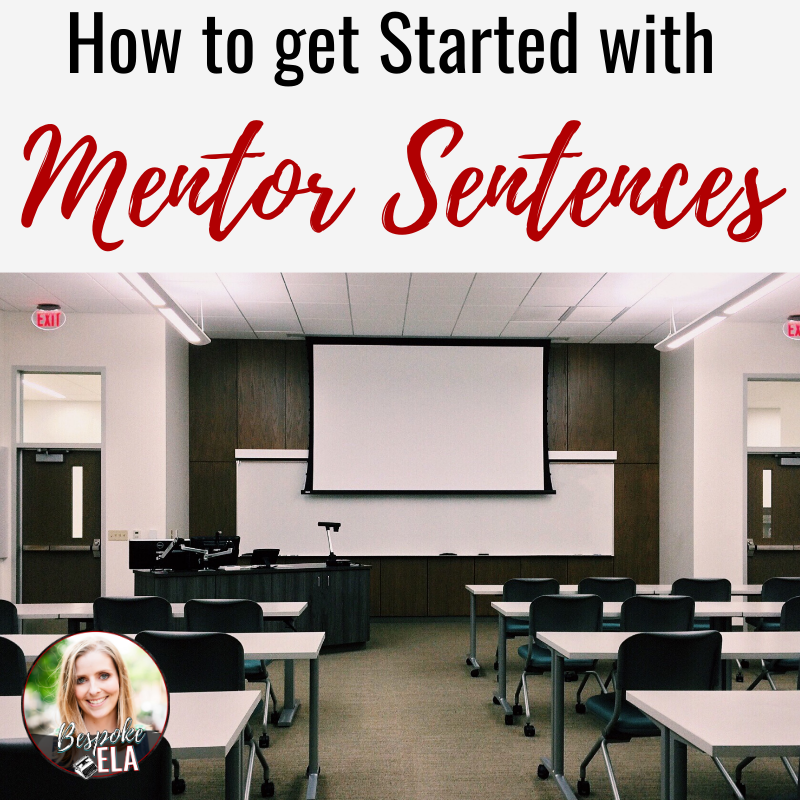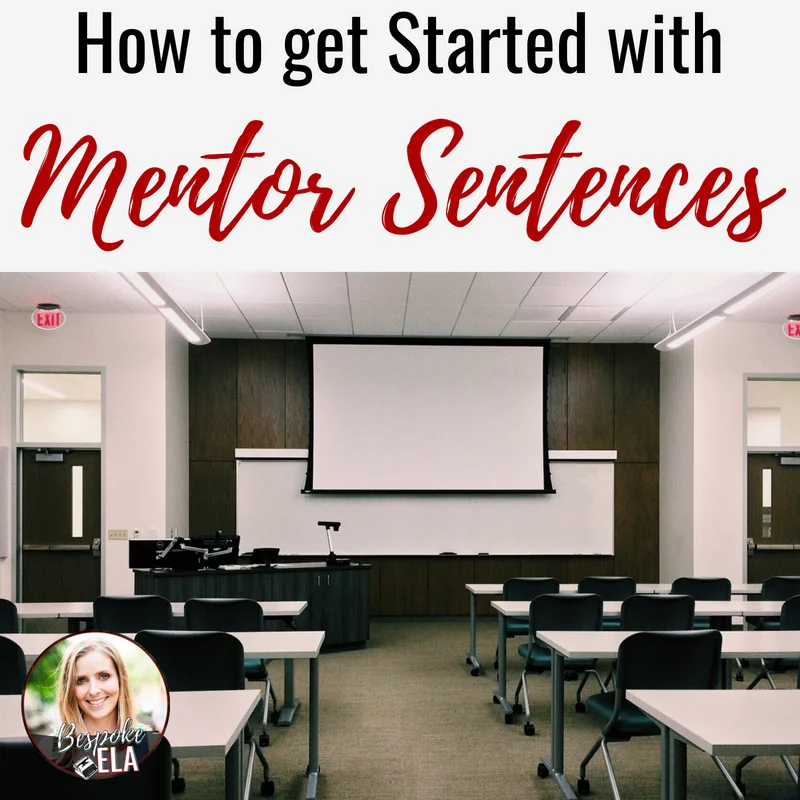Mentor sentences are an excellent tool to use in the secondary ELA classroom to model essential skills from grammar to literary devices. They reinforce quality writing skills from published authors in a positive way rather than the traditional sentence correction method that models negative traits.
But getting started with mentor sentences can be a challenge. New teachers to this strategy may find themselves asking these questions:
How do I get started with mentor sentences?
How do I sequence instruction with mentor sentences?
What exactly do I have students do with a mentor sentence?
Below, I have answered these questions to get you started with mentor sentences!
Sentence Selection
The first cardinal rule of selecting mentor sentences is that they will be more effective if they come from what the students are reading. This makes the experience more organic rather than having students observe random sentences on Power Point slides. However, this method can also be effective depending upon the targeted skills and curriculum.
The sentences you select to serve as mentor sentences depend on how you want to use them in the classroom. Do you want to model grammar rules? Do you want to model literary devices? Do you want students to admire a particularly beautiful sentence? Or do you want students to admire interesting sentences while reading even if it means the skills are not cohesive? Determine how you want to fit mentor sentences into your overall curriculum and then select sentences that model those specific skills.
In my classes, I've selected mentor sentences that I've found particularly striking in style for differing reasons, but I've also used mentor sentences to model literary devices as we read a particular novel. Decide upon which approach will work best for your students and curriculum. In my bundle of 30 MENTOR SENTENCES for Literary & Rhetorical Devices with Writing Revision, I include a collection of 30 mentor sentences from both fiction and non-fiction that model an assortment of skills. Many of these sentences model more than one skill at a time, making them excellent lessons even for whole class periods and deeper style analysis.
Locating mentor sentences can be quite time-consuming and lengthy; however, remember that you have a classroom full of students! They, too, can find mentor sentences even as a homework assignment. Have students find sentences that demonstrate a specific skill and share them in small groups or with the entire class.
The Mentor Sentence Process
At this point, you may be thinking: I have a mentor sentence, but what do I do with it?
Here are the basic steps of what to do with a mentor sentence:
1. Have students write down the mentor sentence. They can write it down in their notebooks or a on a sheet of paper. I like to have my students keep a section in their notebooks titled "Mentor Sentences." We begin with these almost every class period as bell-ringers, so students know to come into class and open their notebooks for mentor sentence time.
2. Have students make observations about the sentence. Students should share what they observe about the sentence either with a small group or the entire class. These observations can range from the structure of the sentence to the word choice and more!
3. Identify the specific skill in the sentence you want them to learn, and have students write down this grammar rule, literary device, etc. Students should add this information to their notes.
4. After students write down the targeted skill, instruct students to craft a sentence of their own using the same structure as the mentor sentence. They can either select a topic of their choice, or you can give them a specific topic. The purpose of this part in the process is to experiment with the new skill.
5. Have students share some of their sentences with the class. They can either write them on the board, project them on an ELMO, or share with a partner sitting near them. Students should check to make sure that their partners have crafted a sentence in the same structure as the original, mentor sentence. You can go around the room and check some of their sentences while they share. You can even have them turn them in if you feel that you need to check understanding for a specific skill.
6. This step is very important! After students practice the new skill from the mentor sentence, they should go back to a piece of writing and revise a sentence in the same structure as the mentor sentence. Mentor sentences need to be connected to the writing process because this is how students will learn to vary their style and also gain new options for grammatical structures and devices.
7. After students revise a piece of writing using the mentor sentence model, it's time to reflect! Students will write a sentence or two explaining what they learned, where they added the modeled sentence, and why. This step in the process encourages students to think conscientiously about purposeful revision and editing. These changes should be made on purpose for a desired effect or outcome. Students can share these reflections in class as time permits.
This is the same process as the sentences found in 30 MENTOR SENTENCES for Literary & Rhetorical Devices with Writing Revision. This bundle also includes a Power Point version to make it easier to show students the mentor sentences in class.
Skills to Assess with Mentor Sentences
I divide my mentor sentences into two camps: #1) grammar and #2) literary/ rhetorical devices and style. For mentor sentences on grammar skills, I mainly focus on common grammar mistakes. These include:
Subject-verb agreement
Sentence Structure and punctuation (compound sentences and complex sentences)
Sentence fragments and run-ons
Commas and introductory elements
Misusing apostrophes
Dangling modifiers
Ambiguous pronouns
Parallel Structure
Wrong word usage
Comma usage
Comma splice
Concise sentences
Colon mistakes
Split Infinitives
Your study of literary and rhetorical devices can go as far into the terminology as fits the needs of your curriculum. If you teach Advanced Placement, this means you will be getting into the weeds on these devices, so students will need to practice them with ample mentor sentences. Here are the basic devices I include in mentor sentence bell-ringers for all levels of ELA:
Simile
Metaphor
Personification
Allusion
Apostrophe
Consonance
Assonance
Parallel Structure
Antithesis
Anaphora
Epistrophe
Rhetorical Question
Repetition
Contrast
Juxtaposition
Shift
There are many more terms where these come from, and you can add to this list according to the needs of your students! 30 MENTOR SENTENCES for Literary & Rhetorical Devices with Writing Revision includes skills that go to the Advanced Placement level, but you can modify these skills as needed for your students.
The Trap of Using Mentor Sentences
The trap of using mentor sentences is that not all authors follow the rules of grammar. Rules were made to broken, am I right? Famous authors break rules all the time! Stephen King likes to split his infinitives. Hemingway liked to use run-on sentences. So, turning to these great authors may not be the best choice when it comes to providing models for grammar. However, it is crucial that you speak with your students about these rule-breakers. Students need to understand that rules can be broken in creative writing, but we are NOT ALLOWED to break these rules in academic writing. Academic writing must follow grammatical protocols and rules completely. It's a different "voice" of writing than a novel. When you and your students come across sentences that break rules, use it as an opportunity to discuss the rule that was broken and how the sentence can be corrected. I point out some of these rule-breakers in 30 MENTOR SENTENCES for Literary & Rhetorical Devices with Writing Revision. Students will have FUN taking a red pen to Dickens, one of the greatest writers that ever lived!
The Takeaway
Mentor sentences are an excellent tool to target writing skills in the ELA classroom. You can use them as bell-ringers or even as full-period lessons! With lots of possibilities for skills to model, mentor sentences can help your students diversify the style of their writing in an organic way. I highly encourage you to give them a try this school year!
About the Author
Meredith is the founder and creator of TeachWriting.org and Bespoke ELA. She has taught high school English for 10+ years in Dallas, Chicago, and New York City and holds a M.A. in Literature from Northwestern University. She has always had a connection to the written word-- through songwriting, screenplay writing, and essay writing-- and she enjoys the process of teaching students how to express their ideas. An avid tea drinker and anglophile, Meredith enjoys life with her husband, daughter, and sweet pups.









